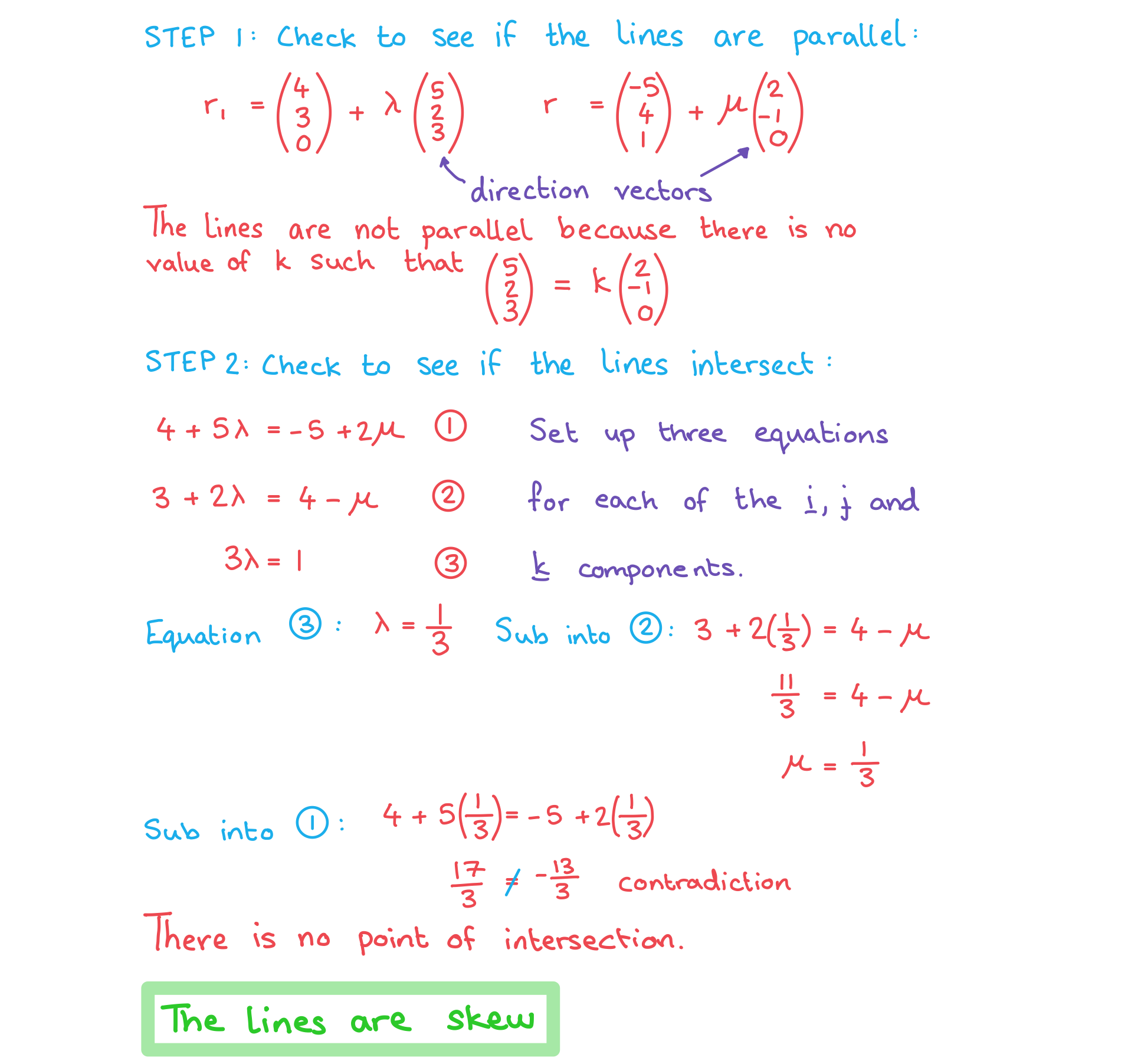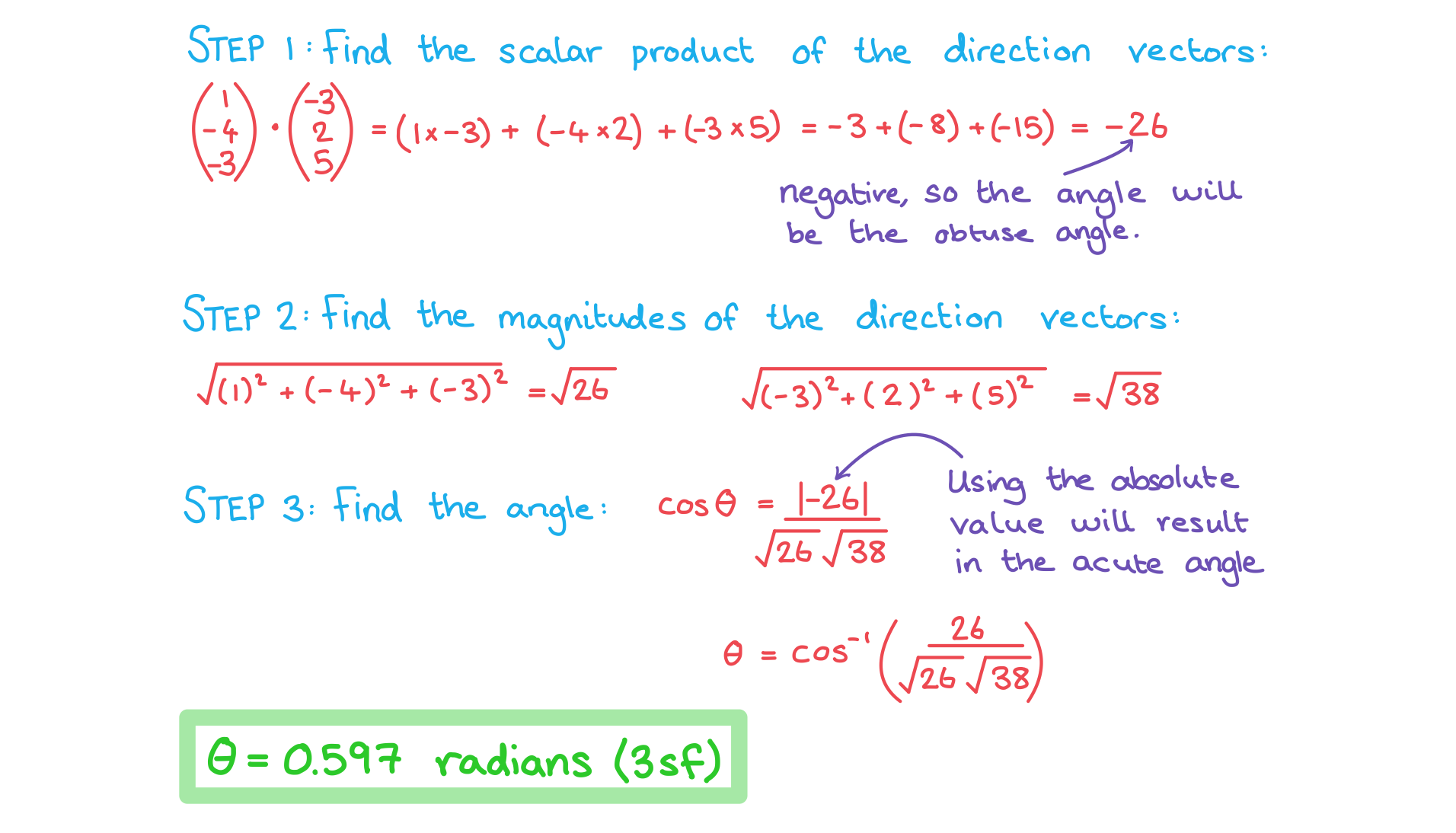Coincident, Parallel, Intersecting & Skew Lines
How do I tell if two lines are parallel?
- Two lines are parallel if, and only if, their direction vectors are parallel
- This means the direction vectors will be scalar multiples of each other
- For example, the lines whose equations are
and
are parallel
- This is because
- This is because
How do I tell if two lines are coincident?
- Coincident lines are two lines that lie directly on top of each other
- They are indistinguishable from each other
- Two parallel lines will either never intersect or they are coincident (identical)
- Sometimes the vector equations of the lines may look different
- for example, the lines represented by the equations
and
are coincident,
- for example, the lines represented by the equations
- To check whether two lines are coincident:
- First check that they are parallel
- They are because
and so their direction vectors are parallel
- They are because
- Next, determine whether any point on one of the lines also lies on the other
is the position vector of a point on the first line and
so it also lies on the second line
- If two parallel lines share any point, then they share all points and are coincident
- First check that they are parallel
- Sometimes the vector equations of the lines may look different
What are skew lines?
- Lines that are not parallel and which do not intersect are called skew lines
- This is only possible in 3-dimensions
How do I determine whether lines in 3 dimensions are parallel, skew, or intersecting?
- First, look to see if the direction vectors are parallel:
- if the direction vectors are parallel, then the lines are parallel
- if the direction vectors are not parallel, the lines are not parallel
- If the lines are parallel, check to see if the lines are coincident:
- If they share any point, then they are coincident
- If any point on one line is not on the other line, then the lines are not coincident
- If the lines are not parallel, check whether they intersect:
- STEP 1: Set the vector equations of the two lines equal to each other with different variables
- e.g. λ and μ, for the parameters
- STEP 2: Write the three separate equations for the i, j, and k components in terms of λ and μ
- STEP 3: Solve two of the equations to find a value for λ and μ
- STEP 4: Check whether the values of λ and μ you have found satisfy the third equation
- If all three equations are satisfied, then the lines intersect
- If not all three equations are satisfied, then the lines are skew
- STEP 1: Set the vector equations of the two lines equal to each other with different variables
How do I find the point of intersection of two lines?
- If a pair of lines are not parallel and do intersect, a unique point of intersection can be found
- If the two lines intersect, there will be a single point that will lie on both lines
- Follow the steps above to find the values of λ and μ that satisfy all three equations
- STEP 5: Substitute either the value of λ or the value of μ into one of the vector equations to find the position vector of the point where the lines intersect
- It is always a good idea to check in the other equations as well, you should get the same point for each line
Exam Tip
- Make sure that you use different letters, e.g.
and
, to represent the parameters in vector equations of different lines
- Check that the variable you are using has not already been used in the question
Worked Example
Determine whether the following pair of lines are parallel, intersect, or are skew.
and
.

Angle Between Two Lines
How do we find the angle between two lines?
- The angle between two lines is equal to the angle between their direction vectors
- It can be found using the scalar product of their direction vectors
- Given two lines in the form
and
use the formula
- If you are given the equations of the lines in a different form or two points on a line you will need to find their direction vectors first
- To find the angle ABC the vectors BA and BC would be used, both starting from the point B
- The intersection of two lines will always create two angles, an acute one and an obtuse one
- These two angles will add to 180°
- You may need to subtract your answer from 180° to find the angle you are looking for
- A positive scalar product will result in the acute angle and a negative scalar product will result in the obtuse angle
- Using the absolute value of the scalar product will always result in the acute angle
Exam Tip
- In your exam read the question carefully to see if you need to find the acute or obtuse angle
- When revising, get into the practice of double checking at the end of a question whether your angle is acute or obtuse and whether this fits the question
Worked Example
Find the acute angle, in radians between the two lines defined by the equations:
and

